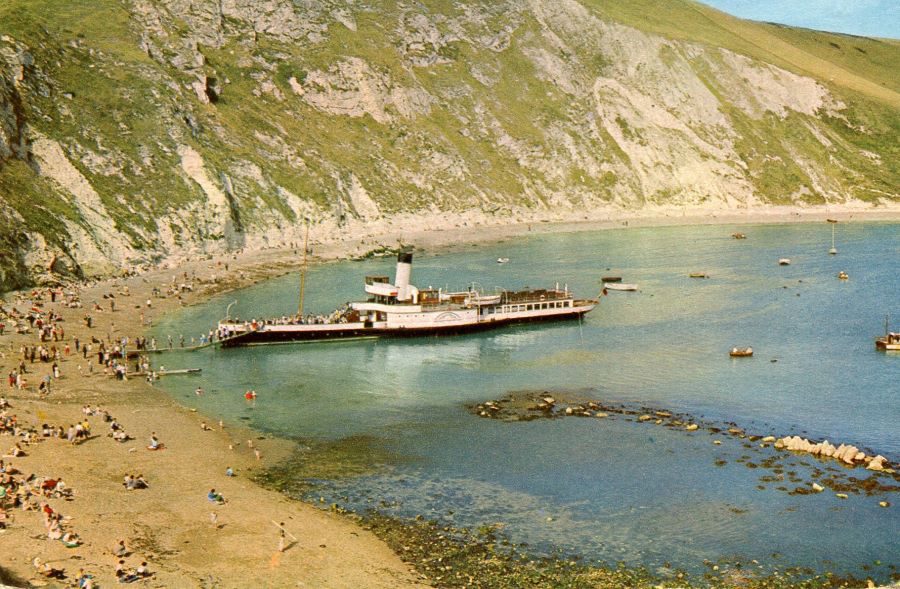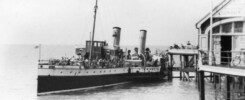Weymouth was one of the first seaside towns in the UK to turn itself into a holiday destination and resort. In the mid 18th century Bath entrepreneur Ralph Allen spotted its magnificent beach and tiny tidal range of less than 2m and started coming down to stay. He brought his aristocratic friends with him including the Duke of This, the Duke of That and the Duke of Something else. They invited the King’s brother and he invited the King. As a result George III spent all his summers, bar two, taking the waters at Weymouth from 1789 to 1805.
The town suffered a slight setback when his son, the Prince Regent, cast his favours on Brighton instead but Weymouth remained a major destination for the moneyed elite right up to the arrival of the railway in 1857. After that many of the rich and powerful went elsewhere and gradually, over the next hundred years and right up to the 1960s, Weymouth became a mass market destination with a strong appeal to factory workers, most particularly from the Midlands, and the mining communities of South Wales. They came in their droves and packed the splendid beach to, and sometimes beyond, capacity each summer.
This market segment had sufficient money for their annual holidays but they were not that flush with spare cash and this was reflected in the sort of paddle steamer cruises offered from the Weymouth Pleasure Pier by Cosens and the fares set for them.

This resulted in there being a big market for short local trips. And Weymouth was particularly suited to this as by an accident of its geography it could offer no less than five different trip options all involving a run of seven nautical miles. “Round HM Ships and Merchant Shipping in Portland harbour”: 7 miles. “Tea Cruise to the Bill of Portland”: 7 miles each way. “Tea Cruise to the Shambles Lightship”: 7 miles each way. “Coffee Cruise” and “Cruise across Weymouth Bay towards Osmington, Ringstead and Lulworth Cove thence to Portland Harbour”: less than 14 miles for the round trip. “Lulworth Cove”: 7 miles each way.
For paddle steamers with a speed of around 11 knots this was ideal. They could easily do a 7 mile trip within an hour or a 7 miles each way trip in two hours or less with ample slack built into it to cope with adverse tides. It also left sufficient time to tie up to the Shambles Lightship to exchange gifts from the passengers with fresh fish from the lightship crew and to load an unload passengers in Lulworth Cove. And none of this generally required the steamers to be pushed on at a higher speed to keep to time. Cosens well understood that pushing a ship’s speed up when in a real hurry eats up fuel at a disproportionately higher rate.
Take a look at this steamer notice for Consul for Saturday 17th June to Sunday 25th June 1962 and dream.

I sailed as an 11 year old passenger quite often on Consul during the 1962 season, generally on my own and without my parents or anybody else with me. I went down to Cosens’s kiosk at the entrance to the Pleasure Pier, bought a ticket with my pocket money and off I went. I tried to go on all the trip options, many more than once, and noticed towards the end of the season that so far I hadn’t been on a “Coffee Cruise”. I put this right on Tuesday 4th September boarding for the 10.45am departure and going down to the dining saloon on the main deck aft to claim my free coffee which was included in the price. I remember Mr Lloyd Edwards, who ran the catering on behalf of Cosens, asking me if I would prefer an orange juice instead which I thought was a nice gesture. He was a kind man who I had got to know through my frequent appearances aboard Consul that summer and through my modest purchases of the occasional pineapple juice, which made me feel rather grown up, a box of currants covered in chocolate, rather less so, and, if I was feeling particularly flush, a delicious fresh crab sandwich made specially by his nice lady assistant.

Of course there were other longer trip options also available from Weymouth by Cosens in earlier years with the most popular, and long lasting, being a 10am departure for Swanage with an extension to Bournemouth for any who wanted. Swanage is 22 miles east of Weymouth with the cruise passing Durdle Door, Lulworth Cove, Chapman’s Pool and then rounding St Albans Head, Anvil Point, Durlston Head and Peveril Point. That is just over 3 x 7 nautical miles so this was easily achievable in under three hours without pushing the steamers. It was also a nice voyage time for a lovely day trip along the beautiful Dorset Coast but it was not too long to risk the passengers becoming bored.
Aware of the Weymouth market’s pocket, Cosens pitched the day trip fare for this cruise, with a round trip steaming time of just under 6 hours, in the last season that Consul ran to Swanage and Bournemouth in 1961 at 10/6. Contrast that with the 1961 day trip fare on their Embassy from the more moneyed resort of Bournemouth to Totland Bay or Yarmouth, Isle of Wight, which had a round trip steaming time of just 3 hours, which was 16s. And if you had wanted to add on the coach tour of the Isle of Wight, and could have afforded it, then that would have come in at 24/-. That’s almost two and a half times as expensive as the day trip fare from Weymouth to Swanage.
I recall Capt Harry Defrates telling me that when he first took command of the Consul he had noticed the preponderance of flat caps atop the heads of the male passengers boarding at Weymouth. Then at Swanage most of the flat caps went ashore and were replaced on the leg to Bournemouth with a preponderance of tweedy sports jackets. It is a little thing but it is significant.
Many years ago I attended a marketing segmentation course which looked at what a business offers, who might want to buy the product, how you might tailor your business to meet a demand or how you might not want to tailor your business to meet a particular demand if you can’t realistically fulfil expectations. And you should never be shy of steering clear of any particular market segment if you and your team don’t feel that it is right for your company. An underlying theme was about choosing the markets which make a good fit for your product. I remember one of the mantras was that you should never try to offer “something for everybody” as in diluting what you are trying to achieve so broadly you are in danger of ending up pleasing nobody and thereby providing “nothing for anybody”. On the first morning the tutor started by going round the room asking what we had all eaten for breakfast. Some replied bacon and eggs. Others had porridge. Some had tucked into toast and marmalade. One lady had consumed a bowl of chicken soup.That did the trick for us. It woke us up to the fact that potential customers are not a homogeneous group. People are different. Different people like different things. Different people can afford or not afford different things.
Cosens were astute financial operators. They knew their markets. They knew what each of their market segments wanted. They knew what each of their market segments could afford and pitched their trips and their fares accordingly.
Kingswear Castle returned to service in 2023 after the first part of a major rebuild which is designed to set her up for the next 25 years running on the River Dart. The Paddle Steamer Kingswear Castle Trust is now fund raising for the second phase of the rebuild. You can read more about the rebuilds and how you can help if you can here.
John Megoran


